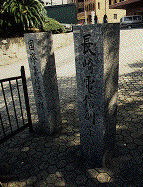
|
||

|
In February of the sixth year of the Meiji Period (1873), the Japanese government decided to open a telegraph line between Tokyo and Nagasaki on land. Before that, the government commissioned the Daihoku Telegraph Company in Denmark to lay submarine telegraph cables and signed a thirty-year contract. This contract included an article stipulating "The Daihoku Telegraph Company will cancel the construction of land telegraph lines between Tokyo and Nagasaki if it is completed quickly and without technical problems." The government, which was short of foreign currencies, hastened the construction of the land telegraph line and started it in August 1871. Not relying on the Daihoku Telegraph Company, the telegraph line was constructed and opened. At a time when the power of the government was not yet established, telegraph offices became the target of hate as a symbol of the new civilization. The telegraph line extending along the Tokaido route represented vividly the change of an era. | |

|
||